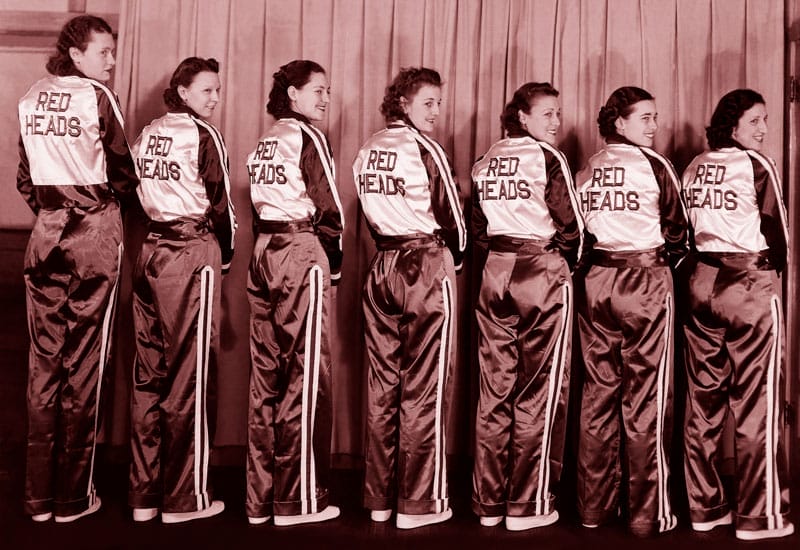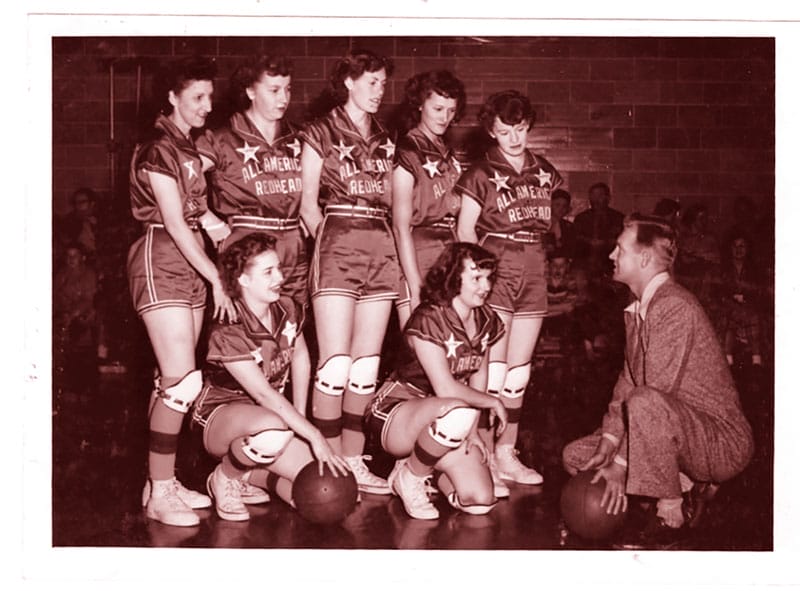James Naismith invented the game of basketball in 1891 as an exercise program for college men, which was soon adapted for college women. But that caused a backlash. Medical professionals, religious leaders, and education experts said basketball was “unhealthy, unladylike, and inappropriate for young ladies.” It was even thought that exercise, like running, would prevent women from bearing children later on. By the 1920s, girls’ and women’s basketball had been banned at elementary schools, high schools, and colleges.
In 1936, C. M. “Ole” Olson came up with the wild-hair idea to combine basketball and the world of beauty to create a professional basketball team that would dispel its harmful reputation for women. His wife, Doyle, owned several hair salons in Cassville and the surrounding area. Some of the women who worked in her salons liked to shoot hoops after work. Besides recruiting those women, Ole recruited from local amateur basketball teams. That got the ball rolling.
They needed a catchy name though. Two women on the team were naturally redheaded. As a way to advertise her salons, Doyle dyed the other players’ hair red with henna. Thus, the name Cassville Red Heads was born. Before the end of the year, though, the name was changed to Missouri Red Heads. Ole then signed on members from the Amateur Athletic Union from across the United States and changed the team’s name to the All American Red Heads.
Ole knew what it took to succeed since he had been a player on and then an owner of a men’s basketball team called the Terrible Swedes. The team traveled nation- wide in the 1920s and into the early 1930s and showcased on-court antics and exceptional ball handling, much like the world-famous Harlem Globetrotters, who also began in the 1920s but achieved their international fame in the 1940s.
Ole taught the women trick shots and passing skills he had used on the court. Since there were no other women’s teams to play against, Ole booked them against men’s teams, playing by men’s rules on a full court with a men’s sized basketball.
He was also a marketing genius, promoting the team from coast to coast. They barnstormed the country, logging more than 40,000 miles a season. Starting in the eastern United States and working their way to the west coast, they played about 200 games from September to May. And the Red Heads were winning most of the time.
During the 1936–1937 season, the team entertained 200,000 spectators. The following season they per- formed in front of 300,000 people in 185 games in about 30 states. The Red Heads were red-hot!
“Bookings are in demand so much that in larger cities they are playing both afternoon and evening. They not only pack in the crowds but they are a crowd-pleaser,” according to an article published in the Helena, Montana, Independent Record newspaper on March 10, 1941. They played in New York City and Chicago but also in towns with less than 200 residents.
People were in awe to see young women wearing short outfits but more amazed at their trick moves and fancy passing.

What a Life!
Every day was hectic. On the road, they were cooped up and crammed into a nine- passenger station wagon, and they played games seven nights a week with doubleheaders on Sunday, checked in and out of hotels, ate out all the time, and washed out their uniforms in bathtubs. “We play every night on a different court,” Coach Wilbur Surface said in the 1930s.
For variety, the girls rotated the seating in the vehicle daily and took turns each morning loading luggage on top.
In 1940, they traveled to the Philippines. The Cassville Republican newspaper noted on April 18, “C. M. Olson of this city, and his nationally known basketball team, the All American Red Heads, sailed at 4 PM yesterday on the steamer S. S. Granville from Los Angeles to the Philippine Islands to play 40 games.” When rumors of Japan’s impending invasion spread, the Red Heads were quickly shuttled away in a cattle boat. Due to gas shortages and men off fighting in World War II, the team’s travel was suspended in 1943.
In 1948, Ole hired Orwell “Red” Moore to coach a spin- off of the All American Red Heads, a rookie team called the Famous Red Heads. The Famous Red Heads was a starting place for players who were recruited but needed more skills before they could become a member of the All American team. Redheaded Orwell would only accept the role if his wife, Lorene, nicknamed “Butch,” was hired as a player on the All American Red Heads team. Ole agreed.
It was a win-win situation. Butch played for 12 years, racking up 35,426 points, while Orwell’s business and marketing sense took the team of women athletes and entertainers to new heights.
“I knew we all needed to practice with enthusiasm, hard work, and teamwork,” he said. Orwell followed Ole’s philosophy of instilling a sense of pride and confidence in the women. Orwell added a humorous halftime show to demonstrate their spectacular gags, juggling, passing, shooting, ball handling, and spinning of the ball on one finger.
In 1955, Ole retired and sold the team to Orwell, who moved the team’s headquarters to his hometown of Caraway, Arkansas.
By the 1970s, because of their popularity and to keep up with all the bookings, in addition to the All American team, there was also one or sometimes two Famous Red Heads teams traveling the country. They were so popular that Edward D. Stevens and Associates sent a telegram to Orwell on October 8, 1969, offering one million dollars to buy all rights to the All American Red Heads. He refused.
The press was taking notice. Team members did radio interviews and were written about in numerous newspapers and magazines such as Life, Look, Collier’s, and Sports Illustrated. They appeared on The Ed Sullivan Show, To Tell the Truth, What’s My Line?, The Mike Douglas Show, and Art Linkletter’s House Party.

Who They Were
Many women recall their experiences with the Red Heads. Jolene “Jo Jo” Ammons started in 1962 at age 20. She came from Georgia and played for 12 years, including the last two as a player and coach, scoring more than 20,000 points. She recalls helping Betty White, a guest on The Mike Douglas Show, spin a ball with one finger. She now lives in Florida.
She also remembers loading luggage on top of the station wagon. “Storage and weight were big factors when you think about seven players, driver, and all the suitcases and equipment. When there was too much weight, the coach told us to send some clothes home.” In the 1970s, they switched to a 36-foot Oldsmobile Toronado limousine. It allowed more room for people, luggage, and equipment, although they were still each limited to one suitcase, a cosmetic bag, and duffel bag for two uniforms and equipment. Jolene initially disliked her carrot top, dyed with Clairol Flame Red. Eventually becoming used to it, she says, “I had forgotten my real hair color.”
Donna “Spanky” Losier, from New Hampshire, signed up for the team at age 18. She scored 20,721 points during her 11 years on the team, which were from 1967–1978. At just 5’5″, she recalls Orwell telling her, “I don’t care if you’re tall enough, but you need to be tall in your attitude.” She now lives in Illinois. Always joking and playing the guitar, Donna earned her nickname when Orwell told her she reminded him of Spanky from The Little Rascals television show. “I still go by that nickname,” she says.
Pat Rimer Overman, 5’8″ and from Edina, started with the Red Heads at age 17 and played for 12 years, 1962–1973, scoring some 33,000 points. “My specialty was shooting 10 free throws from down on my knees,” she says. She lives in Jonesboro, Arkansas, today. Because of time restraints in restaurants, Pat always ate dessert while waiting for her food. “To this day, I still eat my dessert first,” she says.
Brenda “Brooksie” O’Bryan Koester, at 6′, signed on with the team at age 20, even though she was married. She was from Cairo, Missouri, which is still her home today. Orwell said, “If you have to call your husband, the deals off.” She replied, “Give me a pen!” She played for three years, 1970–1973, accumulating 10,017 points.
Brooksie and Lynn Holst weren’t on the same team but wanted to be. They worked all summer practicing a double-dribbling act, which had each dribbling two balls while Lynn, the shorter player at 5’4″, went between Brooksie’s legs, and they exchanged balls without missing a beat. When they showed it to Orwell, he put them on the same team and made the act a permanent part of the halftime show. Lynn was from near Hazelwood and now lives in Macon.
She recalls car trouble on the road. “Once a front wheel flew off, went bouncing over a hill, hit the top of a house, and landed beside a dog. We went running after it. We got used to changing tires.”
Carolyn “Gooch” Hix, 6’2″, didn’t think she would make the team when she missed all three free throws at the tryout. Orwell still signed her, saying, “You have sparkle.” Confused, she later learned he meant passion, pizazz, style, and femininity. She was on the team for three years, 1968–1970. She came from Truman, Arkansas, and now lives in Austin, Texas.

The Way Forward
The signing of Title IX in 1972, which barred federally funded education institutions from discriminating based on sex, ensured that girls would be included in school sports alongside comparable boys teams. In 1972, the Red Heads won 96 games in a row, but by 1986, the team was retired. They were the longest running women’s professional basketball team to date. The final game was played in their birthplace, Cassville, Missouri.
Besides the Philippines, they had performed in Canada, Mexico, and 49 states, including four times in Alaska. Pat Overman said, “We got to play a game we loved, got to travel, and got paid to do it!”
Tammy Moore Harrison, daughter of Orwell and Lorene, summed it up, “The Red Heads paved the way for much greater opportunities for women in sports.”

Honors, Awards, and a Museum
The Barry County Historical Museum at Cassville has a permanent exhibit honoring the All American Red Heads that displays uniforms, photos, posters, books, and several notebooks full of newspaper and magazine articles written about them.
2010: Honored at the Senior Pan-American Games, Eugene, Oregon. While having a reunion there, former players suited up and played alumni of the NBA Portland Trail Blazers.
2011: Named Trailblazers of the Game at the Women’s Basketball Hall of Fame, Knoxville, Tennessee. A permanent display dedicated to the All American Red Heads features one of their 36-foot limousines that the team traveled in.
2012: Inducted into the Naismith Memorial Basketball Hall of Fame, Springfield, Massachusetts, the pinnacle of owner Orwell Moore’s aspirations. This town is also where the game of basketball was invented by James Naismith in 1891.
2013: Inducted into the New England Basketball Hall of Fame. Team members from that region accepted the award on behalf of all the All American Red Heads.
2017: Inducted into the Missouri Sports Hall of Fame, Springfield. The All American Red Heads started as the Cassville Red Heads in Cassville in 1936 and were headquartered there until 1954.
2020: Inducted into the Arkansas Sports Hall of Fame, North Little Rock, Arkansas. The All American Red Heads were headquartered in Caraway, Arkansas, from 1955–1986. There were 76 young women recruited from Arkansas for the team, more than from any other state.
Article originally in October 2024 issue of Missouri Life.






